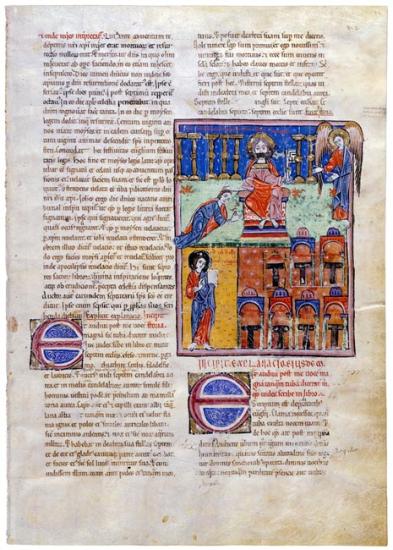
Vision Of The Seven Candlesticks And The Son Of Man
Beatus of Liébana
Las Huelgas Apocalypse
Purchased by Pierpont Morgan, 1910
And I turned around to see the voice which was speaking with me, and I saw seven golden candlesticks: in the midst of the candlesticks was one resembling the son of man, clothed to the feet with a vestment, and wrapped to the breast with a wide belt of gold. But his head and hair were bright, like white wool, or like snow; and his eyes were like a flame of fire. And in his right hand he held the seven stars; and from his mouth went out a sharp two-edged sword. I fell at his feet as dead, and he laid his right hand upon me, saying: "Do not be afraid. I am the First and the Last, and alive, though I was dead. And behold, I live forever and ever, and hold the keys of death and of hell. Therefore, write the things which you have seen, and which are, and which must occur afterward. The seven stars are the angels of the seven Churches, and the seven candlesticks are the seven Churches." (Rev. 1:12–20)
The son of man's tunic is gold at the neck, and the sword in his mouth is silver. Most of the red stars have flaked off. Below, John holds a book or letter, while to the right are the seven churches, each identified with a red inscription (Ephesus, Smyrna, Pergamum, Thyatira, Sardis, Philadelphia, and Laodicea).
The Apocalypse, or Book of Revelation, is not only the last Book of the New Testament, but its most difficult, puzzling, and terrifying. It provided challenges to medieval illustrators and was the source for a number of popular images, such as Christ in Majesty, the Adoration of the Lamb, and the Madonna of the Apocalypse and contributed to the widespread use of the Evangelists' symbols.
Selected images from Apocalypse Then: Medieval Illuminations from the Morgan, an exhibition held at the Morgan are presented here. The exhibition celebrates the completion of a facsimile of the Morgan's Las Huelgas Apocalypse—the latest dated (1220) and largest surviving manuscript of a Spanish tradition of illuminated commentaries on the Apocalypse by the monk Beatus of Liébana. The series of manuscripts constitutes Spain's most important contribution to medieval manuscript illumination.
The Las Huelgas Apocalypse contains three sections: the prefatory cycle, the Apocalypse, and the Book of Daniel.
In addition to forty-nine images from the Las Huelgas Apocalypse, six images from other manuscripts in the Morgan's collections, including the earliest Beatus painted by Maius and one by the Master of the Berry Apocalypse, are in this presentation.
